Items Similar to Art Noveau Bronze vase by Hugo Elmqvist, Sweden, ca 1900
Want more images or videos?
Request additional images or videos from the seller
1 of 10
Art Noveau Bronze vase by Hugo Elmqvist, Sweden, ca 1900
About the Item
Beautiful Art Noveau vase in black patinated bronze, designed by Hugo Elmqvist. Elegant clean form with relief decor of leaves, flowers and dragonflies around the mouth.
- Creator:Hugo Elmqvist (Maker)
- Dimensions:Height: 13 in (33 cm)Diameter: 4.34 in (11 cm)
- Style:Scandinavian Modern (Of the Period)
- Materials and Techniques:
- Place of Origin:
- Period:1900-1909
- Date of Manufacture:1900
- Condition:Wear consistent with age and use.
- Seller Location:Stockholm, SE
- Reference Number:1stDibs: LU1638237871932
About the Seller
5.0
Recognized Seller
These prestigious sellers are industry leaders and represent the highest echelon for item quality and design.
Platinum Seller
These expertly vetted sellers are 1stDibs' most experienced sellers and are rated highest by our customers.
Established in 1973
1stDibs seller since 2015
443 sales on 1stDibs
Typical response time: <1 hour
- ShippingRetrieving quote...Ships From: Stockholm, Sweden
- Return PolicyA return for this item may be initiated within 14 days of delivery.
More From This SellerView All
- Art Noveau Bronze vase by Hugo Elmqvist, Sweden, ca 1900Located in Stockholm, SEBeautiful Art Noveau vase in patinated bronze, designed by Hugo Elmqvist. Stately form with a heavy base, decorated with a dynamic relief of seaweed and crabs.Category
Antique Early 1900s Swedish Scandinavian Modern Vases
MaterialsBronze
- Art Noveau Bronze vase by Gerda Backlund, Sweden, ca 1900Located in Stockholm, SEBeautiful Art Noveau vase in patinated bronze, designed by Gerda Backlund. Slender, curvesome form with relief decor of grasses draping around the base, unfolding ferns around the to...Category
Antique Early 1900s Swedish Scandinavian Modern Vases
MaterialsBronze
- Vintage Mid-Century Patinated Bronze Vase, GAB, Sweden, 1930sBy GAB GuldsmedsaktiebolagetLocated in Stockholm, SEBeautiful 1930s bronze vase, hand cast at Guldsmedsaktiebolaget, GAB, and finished with moss green patina. GAB was founded in Stockholm in 1867 and was an important influence on the...Category
Vintage 1930s Swedish Scandinavian Modern Vases
MaterialsBronze
- Vintage Mid-Century Patinated Bronze Vase, GAB, Sweden, 1930sBy GAB GuldsmedsaktiebolagetLocated in Stockholm, SELovely 1930s bronze vase, in a plump form with decorative handles and details. Patinated in beautiful green nuances. GAB was founded in Stockholm in 1867 and was an important influe...Category
Vintage 1930s Swedish Scandinavian Modern Vases
MaterialsBronze
- Stoneware Vase by Berndt Friberg, Gustavsberg, Sweden, 1950sBy Gustavsberg, Berndt FribergLocated in Stockholm, SEStoneware vase by Berndt Friberg, in an elegant, classic form. Amazing blue glaze, sky blue around the neck, with brown streaks. Berndt Friberg was a Swedish ceramicist, renowned ...Category
Vintage 1950s Swedish Scandinavian Modern Vases
MaterialsStoneware
- Stoneware Vase by Berndt Friberg, Gustavsberg, Sweden, 1950sBy Gustavsberg, Berndt FribergLocated in Stockholm, SENeat miniature stoneware vase by Berndt Friberg, in a slim, strict form. Dark blue hare’s fur glaze. Berndt Friberg was a Swedish ceramicist, renowned for his stoneware vases and ...Category
Vintage 1950s Swedish Scandinavian Modern Vases
MaterialsStoneware
You May Also Like
- Vase Designed by Hugo Elmqvist, Sweden, circa 1900Located in Stockholm, SEVase designed by Hugo Elmqvist, Sweden, circa 1900. Bronze. Measure: H 39 cm/ 15 1/4". Carl Hugo Magnus Elmqvist was a certified and well-known sculpt...Category
Antique Early 1900s European Jugendstil Vases
MaterialsBronze
- French Art Nouveau Patinated Bronze Sculptural Iris Vase, ca. 1900Located in New York, NYABOUT IRIS The iris is a special and mysterious flower. Not only because of its striking appearance, but also from an artistic and historical point of view. It is also like a work of art, as though created by Mother Nature. The unique leaves of this plant not only create wonderful shadow casts, but also look as if they were painted by hand. It's no wonder that iris acts as the muse for countless artists, and can be seen in many famous works of art. The iris was first spotted in the time of Pharaoh Thutmose, in 1504 BC. He had the iris inscribed into the wall reliefs of a temple as a sign of his power, as well as decorating his sceptre with motifs of the flower. Since then, the iris has been a symbol of victory in Egypt. But the symbolism of the iris goes further than that. In Japan, the flower represents courage and is the symbol of the boys' festival. In Islamic cultures, the iris is a symbol of prosperity. In Europe, the flower was a popular weapon symbol in the Middle Ages and stood for chivalry. And in Christianity, the iris was seen as a symbol of the trinity because of its three-part flowers. With more than 300 varieties, the iris is now the most popular flower among growers and gardeners following the rose. Countless artists use the iris in their works and the flower is present in all eras. You can see the flower on furniture, vases, jewelry, fabrics, sculptures, coats of arms and much more. Did you know that the iris is also called the sword lily? It's not a coincidence that it used to symbolize physical and emotional pain and suffering caused by a weapon. We also see the flower in religious art, where it's often associated with Mary and Jesus. The iris is also associated with the Greek goddess Iris, where the flower symbolizes reconciliation and divine messages. This is also reflected in many paintings. Finally, the iris is also visible in Dutch and Flemish still-life paintings. This can be in a religious form, incorporated into an object or as a decorative flower. In the Art Nouveau art movement, the iris (along with other plants, such as the birch) was often used as an expression of feminine beauty. With its almost otherworldly appearance, the iris is perfectly suited to the Art Nouveau aesthetic and is featured in many well-known works of art. The poet of that era, Hermann Hesse...Category
Antique Early 1900s French Art Nouveau Planters, Cachepots and Jardinières
MaterialsBronze
- Art Nouveau Silvered Pewter Floor Vase by Hugo Leven, Germany 1900By Hugo LevenLocated in Vienna, ATArt Nouveau silvered pewter floor vase by Hugo Leven, Germany 1900. An ornamental floor vase designed by Hugo Leven featuring a female figure among gingko leaves. The vase is made of silvered pewter. Hugo Leven studied at the Kunstgewerbeschule and then at the Düsseldorf Art Academy. For some time he worked in his father Louis Leven's studio, had numerous contacts with French artists who influenced him greatly, and quickly became known. Engelbert Kayser hired him as the first employee in his studio. From 1895 to 1904 Leven designed numerous models for Kayserzinn; his works had a lasting influence on the pewter foundry of Art Nouveau. He also worked for the Kreuter company in Hanau and other companies that produced metal, silver and stoneware, such as B. Koch & Bergfeld and WMF. From 1904 to 1909 he lived in Bremen. In 1906, Leven's works were on display at the third German arts and crafts...Category
Early 20th Century German Art Nouveau Vases
MaterialsPewter
- Hugo Gehlin, Freeform Vase, Glass, Sweden, 1940sBy Hugo GehlinLocated in High Point, NCA freeform blue-coloured glass vase designed by Hugo Gehlin and produced by Gulaskruf, Sweden, c. 1940s.Category
Vintage 1940s Swedish Scandinavian Modern Vases
MaterialsBlown Glass
- Bronze Art Deco Vase by BOWI, Sweden, 1930sBy SVM Handarbete 1, GAB Guldsmedsaktiebolaget, Sune Bäckström, Just AndersenLocated in Malmö, SEA beautiful art deco bronze vase with amazing patina. Made by Bowi brons in Sweden, 1930s. Great condition, with some light scratches. Stamped 'BRONS' and 'BOWI'.Category
Vintage 1930s Swedish Scandinavian Modern Vases
MaterialsBronze
- French Art Nouveau Iridescent Stoneware & Bronze Vase or Cachepot, ca. 1900sLocated in New York, NYFrench Art Nouveau Ocean Life Theme Vase Cachepot Iridescent Stoneware & Patinated Bronze Crab Appliqué ca. 1900s ABOUT We present here a most unusual and utterly decorative Fren...Category
Antique Early 1900s French Art Nouveau Vases
MaterialsStoneware
Recently Viewed
View AllMore Ways To Browse
18th Century Copper Vase
Delft Vase With Lid
Holland Ming
Le Printemps Vase
35 Inch Vase
Chinese Mantle
Hoganas Aj
Ancient Egyptian Pottery
Salviati Purple
17th Century Copper Vase
Art Nouveau Awaji
Coalport Flower Vases
Pair Longwy Vases
Large Purple Vases For Sale
Lalique Parakeet Vase
Large Mid Century Vase Zsolnay
Modern Blue Decorative Objects
Large Scale Vases





